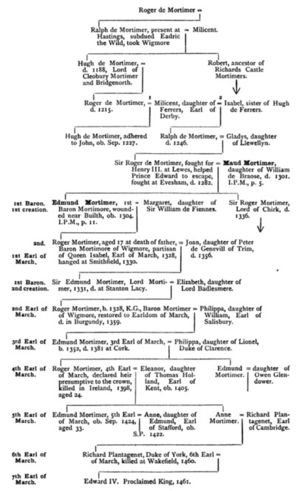Biography
Edmund de Mortimer, 5th Earl of March and Ulster was born in Ireland in 1391, the son of Roger Mortimer[1] and Eleanor Holland.[2] Along with his father's title and estates, he succeeded to his father's claim to the crown of England.
When, in 1399, King Richard ll was deposed and the crown seized by Henry IV, the young Edmund de Mortimer and his brother Roger Mortimer were in the custody of Henry IV. In 1405, they were rescued and moved to Windsor Castle by opponents of Henry lV, Sir Edmund Mortimer, Henry Percy and Owen Glendower; only to be recaptured in 1409 and become hostages of the Prince of Wales.
Roger died in captivity, but Edmund was set at liberty and restored to his estates when Henry V became King.
In 1415, there was a conspiracy to place him on the throne, led by his brother-in-law, Richard, Earl of Cambidge
He fought in France in the army of Henry V. When King Henry died in 1422, he became a member of the council of regency.
Edmund died on 19 January 1425.[3]
He is said to be buried in the Friary of the Austin Friars of Clare, Suffolk, England. [4]
There were no living children and the Earldom of March in the house of Mortimer became extinct.
His next heirs were his nephew Richard Duke of York, son of Anne his sister, Joan wife of John Grey, chevalier, his second sister and Joyce wife of John Typtoft, chevalier, his third sister.[3]
The Mortimer estates passed to Richard Duke of York, Earl of March and Ulster, and Baron of Wigmore. Richard's son Edward IV ascended the throne in 1461, and the earldom of March became merged in the crown.
Sources
- ↑ M. C. B. Dawes, H. C. Johnson, M. M. Condon, C. A. Cook and H. E. Jones, 'Inquisitions Post Mortem, Richard II, Files 104-105', in Calendar of Inquisitions Post Mortem, Volume 17, Richard II (London, 1988), pp. 429-460. British History Online http://www.british-history.ac.uk/inquis-post-mortem/vol17/pp429-460 [accessed 10 December 2020].
- ↑ J. L. Kirby, 'Inquisitions Post Mortem, Henry IV, Entries 1-51', in Calendar of Inquisitions Post Mortem: Volume 19, Henry IV (London, 1992), pp. 1-13. British History Online http://www.british-history.ac.uk/inquis-post-mortem/vol19/pp1-13 [accessed 10 December 2020].
- ↑ 3.0 3.1 King's College London, 2014. | Mapping the Medieval Countryside [online]. Available at http://www.inquisitionspostmortem.ac.uk/view/inquisition/22-467/ [Accessed: 10/12/2020] Inquisitions Post Mortem for Edmund Earl of March 1425
- ↑ The Austin Friars of Clare
- Edmund Mortimer, 5th Earl of March
- Royal Ancestry by Douglas Richardson Vol. I. page 484
- ROYAL ANCESTRY by Douglas Richardson Vol. V page 15
- ROYAL ANCESTRY by Douglas Richardson Vol. IV page 177-8
- Brendan Smith, "Transnational Lordship and the Plantagenet Empire: The Mortimer Lords of Wigmore, 1247-1425". Delivered as the O’Donnell Lecture in May 2015 at Bangor University, Cardiff University and the University of Wales, Trinity Saint David, Lampeter.
No known carriers of Edmund's ancestors' DNA have taken a DNA test.
Have you taken a DNA test? If so, login to add it. If not, see our friends at Ancestry DNA.
Featured National Park champion connections: Edmund is 17 degrees from Theodore Roosevelt, 21 degrees from Stephanus Johannes Paulus Kruger, 17 degrees from George Catlin, 17 degrees from Marjory Douglas, 26 degrees from Sueko Embrey, 16 degrees from George Grinnell, 21 degrees from Anton Kröller, 16 degrees from Stephen Mather, 23 degrees from Kara McKean, 20 degrees from John Muir, 15 degrees from Victoria Hanover and 28 degrees from Charles Young on our single family tree. Login to find your connection.
M > Mortimer > Edmund Mortimer
Categories: Ireland, Governors
